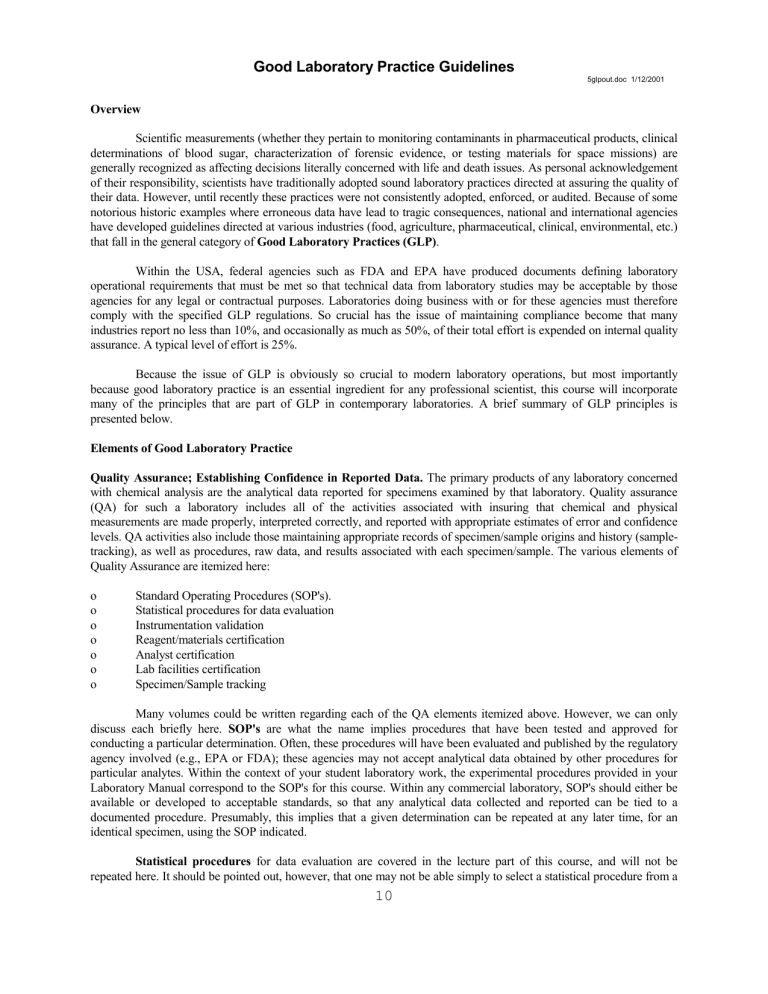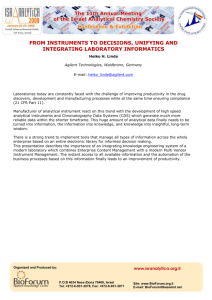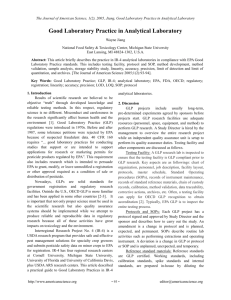Good Laboratory Practices(word)

Overview
Good Laboratory Practice Guidelines
5glpout.doc 1/12/2001
Scientific measurements (whether they pertain to monitoring contaminants in pharmaceutical products, clinical determinations of blood sugar, characterization of forensic evidence, or testing materials for space missions) are generally recognized as affecting decisions literally concerned with life and death issues. As personal acknowledgement of their responsibility, scientists have traditionally adopted sound laboratory practices directed at assuring the quality of their data. However, until recently these practices were not consistently adopted, enforced, or audited. Because of some notorious historic examples where erroneous data have lead to tragic consequences, national and international agencies have developed guidelines directed at various industries (food, agriculture, pharmaceutical, clinical, environmental, etc.) that fall in the general category of Good Laboratory Practices (GLP) .
Within the USA, federal agencies such as FDA and EPA have produced documents defining laboratory operational requirements that must be met so that technical data from laboratory studies may be acceptable by those agencies for any legal or contractual purposes. Laboratories doing business with or for these agencies must therefore comply with the specified GLP regulations. So crucial has the issue of maintaining compliance become that many industries report no less than 10%, and occasionally as much as 50%, of their total effort is expended on internal quality assurance. A typical level of effort is 25%.
Because the issue of GLP is obviously so crucial to modern laboratory operations, but most importantly because good laboratory practice is an essential ingredient for any professional scientist, this course will incorporate many of the principles that are part of GLP in contemporary laboratories. A brief summary of GLP principles is presented below.
Elements of Good Laboratory Practice
Quality Assurance; Establishing Confidence in Reported Data.
The primary products of any laboratory concerned with chemical analysis are the analytical data reported for specimens examined by that laboratory. Quality assurance
(QA) for such a laboratory includes all of the activities associated with insuring that chemical and physical measurements are made properly, interpreted correctly, and reported with appropriate estimates of error and confidence o o o o levels. QA activities also include those maintaining appropriate records of specimen/sample origins and history (sampletracking), as well as procedures, raw data, and results associated with each specimen/sample. The various elements of
Quality Assurance are itemized here:
Standard Operating Procedures (SOP's).
Statistical procedures for data evaluation
Instrumentation validation
Reagent/materials certification o o o
Analyst certification
Lab facilities certification
Specimen/Sample tracking
Many volumes could be written regarding each of the QA elements itemized above. However, we can only discuss each briefly here. SOP's are what the name implies procedures that have been tested and approved for conducting a particular determination. Often, these procedures will have been evaluated and published by the regulatory agency involved (e.g., EPA or FDA); these agencies may not accept analytical data obtained by other procedures for particular analytes. Within the context of your student laboratory work, the experimental procedures provided in your
Laboratory Manual correspond to the SOP's for this course. Within any commercial laboratory, SOP's should either be available or developed to acceptable standards, so that any analytical data collected and reported can be tied to a documented procedure. Presumably, this implies that a given determination can be repeated at any later time, for an identical specimen, using the SOP indicated.
Statistical procedures for data evaluation are covered in the lecture part of this course, and will not be repeated here. It should be pointed out, however, that one may not be able simply to select a statistical procedure from a
10
Master Data Base
Includes critical values for all units calibrated lotus\courses\s20ccF94 graphs
Theor.
Lower
Control
(-2sd)
textbook. Many procedural details are optional and arbitrary. Thus, practitioners in a particular field (e.g., agricultural chemistry, clinical chemistry, etc.) may adopt certain standards which are deemed acceptable within that field (e.g., using 95% or 99% confidence levels for particular tests); or they may adopt specific statistical analysis procedures for defining detection limits, confidence intervals, analyte measurement units, etc. Regulatory agencies often describe acceptable statistical procedures also.
Instrumentation validation is a process inherently necessary for any analytical laboratory. Data produced by
"faulty" instruments may give the appearance of valid data. These events are particularly difficult to detect with modern computer-controlled systems which remove the analyst from the data collection/instrument control functions. Thus, it is essential that some objective procedures be implemented for continuously assessing the validity of instrumental data.
These procedures, when executed on a regular basis, will establish the continuing acceptable operation of laboratory instruments within prescribed specifications. Time-related graphical records of the results of these instrument validation procedures are called "control charts". An example of a control chart documenting performance of a student laboratory instrument is included below. The "control limits"
Control Chart, Spectronic 20
Serial No. 100207
0.44
0.43
0.42
U.C.L.
0.41
0.4
0.39
0.38
0.37
L.C.L.
0.36
11/ 29/ 94 11/ 30/ 94 11/ 30/ 94 11/ 30/ 94 12/ 05/ 94 12/ 06/ 94 12/ 08/ 94
Date
Absorbance Ratio (Dilute/Stock Co) Upper Control Limit
Low er Control Limit
UCL/ LCL = The or. Abs. Ra t io +/ - 2*S .D.(poole d)
Absorba nc e for S t oc k Co (0.170M Nomina l); a nd 0.40 dilut ion. (s20c c f94.wk3.grph2)
Theoretical Abs. Ratio (0.40)
12/ 09/ 94
Control Chart, Spectronic 20
Serial No. 100207
0.95
0.94
0.93
0.92
0.91
0.9
0.89
U.C.L.
0.88
L.C.L.
0.87
11/ 29/ 94 11/ 30/ 94 11/ 30/ 94 11/ 30/ 94 12/ 05/ 94 12/ 06/ 94
Date
Avg. Absorbance (Stock Co), Historical Upper Control Limit
Lower Control Limit
UCL/ LCL = Hist oric a l Avg. Abs. (S t oc k Co) +/ - 2*S .D.(poole d)
Absorba nc e for S t oc k Co (0.170M Nomina l) (s20c c f94.wk3.grph3)
12/ 08/ 94 12/ 09/ 94
11
Perkin-Elmer 303 Atomic Absorption Spectrometer Control Chart Data
Master Data Base lotus\courses\pe303cc
Theor.
Lower
Control
(-2sd)
0.56
0.55
0.54
0.53
0.52
0.51
0.5
0.49
0.48
0.47
0.46
0.45
0.44
Control Chart, PE 303 AA Spectrometer
U.C.L.
11/ 22/ 94 11/ 29/ 94 11/ 29/ 94 12/ 01/ 94 12/ 01/ 94 12/ 01/ 94 12/ 02/ 94
L.C.L.
12/ 02/ 94
Date
12/ 06/ 94
Absorbance Ratio (Low/High Zn)
Lower Control Limit
UCL/ LCL = The or. Abs. Ra t io +/ - 2*S .D.(poole d)
Absorba nc e for S t oc k Zn (0.0077M Nomina l) 1:250 a nd 1:500 (pe 303c c .wk3.grph2)
12/ 06/ 94 12/ 06/ 94 12/ 06/ 94 12/ 06/ 94 12/ 06/ 94
Upper Control Limit
Theoretical Abs. Ratio (0.50)
12/ 08/ 94 assigned as upper and lower ranges around the expected instrumental output are generally related to some accepted measure of the random error expected for the overall procedure. (Typically the control limits will be set at +/- 2(std. dev.). Quality assurance procedures will require that whenever a instrument's performance is outside of the "control limits", use of that instrument to provide analytical reports must be discontinued; the cause of the problem must be determined and fixed if possible; and the instrument must be certified to be operating again with control limits before returning to service for determinations leading to reported analytical data.
Reagent/materials certification is an obvious element of quality assurance. However, GLP guidelines emphasize that certification must follow accepted procedures, and must be adequately documented. Moreover, some guidelines will specify that each container for laboratory reagents/materials must be labeled with information related to its certification value, date, and expiration time. This policy is meant to assure that reagents used are as specified in the
SOP's.
Certification of analysts is a required part of QA. Some acceptable proof of satisfactory training and/or competence with specific laboratory procedures must be established for each analyst. Because the American Chemical
Society does not currently have a policy regarding "certification" of chemists or analysts, the requirements for
"certification" vary, and are usually prescribed by the laboratory in question. These standards would have to be accepted by any agency or client obtaining results from that laboratory. For our student laboratory, the requirement for certification as an analyst is satisfactory completion of the first three laboratory assignments (see lab outline, Series A).
Execution of these basic procedures will be repeated, if necessary, until satisfactory results are obtained (evaluated based on analytical accuracy and precision).
Certification of laboratory facilities is normally done by some external agency. For example, an analytical laboratory might be audited by representatives of a federal agency with which they have a contract. An independent laboratory might file documentation with a responsible state or federal agency. The evaluation is concerned with such issues as space (amount, quality and relevance), ventilation, equipment, storage, hygiene, etc. Student chemistry laboratories are generally evaluated by the American Chemical Society, as part of the process of granting approval for the overall chemistry program presented by the college or university. This latter approval process is not as detailed regarding analytical facilities as the certification processes pursued by agencies concerned specifically with quality assurance.
Specimen/sample-tracking is an aspect of quality assurance which has received a great deal of attention with the advent of computer-based Laboratory Information Management Systems (LIMS). However, whether done by hand with paper files, or by computer with modern bar-coding techniques, sample-tracking is a crucial part of quality assurance. The terms "specimen" and "sample" are often used interchangeably. However, "specimen" usually refers to an item to be characterized chemically; whereas "sample" usually refers to a finite portion of the specimen which is taken for analysis. When the specimen is homogeneous (such as a stable solution), the sample represents the overall composition of the specimen. However, for heterogeneous specimens (e.g., metal alloys, rock, soil, textiles, foods, polymer composites, vitamin capsules, etc.), a sample may not represent the overall composition. Maintaining the distinction in records of analytical results can be crucial to the interpretation of data.
12
Procedures for assuring adequate specimen/sample-tracking will vary among laboratories. The bottom line, however, is that these procedures must maintain the unmistakable connection between a set of analytical data and the specimen and/or samples from which they were obtained. In addition, the original source of the specimen/sample(s) must be recorded and likewise unmistakably connected with the set of analytical data. Finally, in many cases the "chainof-custody" must be specified and validated. This is particularly true for forensic samples (related to criminal prosecution), but can also be essential for many other situations as well. For example, a pharmaceutical company developing a new product may be called upon at some time to defend their interpretation of clinical trial tests. Such defense may require the company to establish that specimens collected during these trials could not have been deliberately tampered. That is, they may have to establish an unbroken chain-of-custody which would remove all doubt regarding the integrity of specimens submitted to chemical analysis.
Documentation and Maintenance of Records.
A central feature of GLP guidelines is the maintenance of records...of specimen/sample-origins, chain-of-custody, raw analytical data, processed analytical data, SOP's, instrument validation results, reagent certification results, analyst certification documents, etc. Maintenance of instrument and reagent certification records provides for post-evaluation of results, even after the passage of several years. Maintenance of all records specified provide documentation which may be required in the event of legal challenges due to repercussions of decisions based on the original analytical results.
So important is this record-keeping feature of GLP that many vendors are now providing many of these capabilities as part of computer packages for operating modern instruments. For example, many modern computer-based instruments will provide for the indefinite storage of raw analytical data for specific samples in a protected (tamperproof) environment. They also provide for maintenance of historical records of control chart data establishing the operational quality of instruments during any period during which analytical data have been acquired by that instrument.
The length of time over which laboratory records should be maintained will vary with the situation. However, the general guidelines followed in regulated laboratories is to maintain records for at least five years. In practice, these records are being maintained much longer. The development of higher density storage devices for digitized data is making this kind of record-keeping possible. The increasing frequency of litigation regarding chemistry-related commercial products is making this kind of record-keeping essential. Moreover, establishing the integrity of the stored data is becoming a high level security issue for companies concerned about future litigation.
All of the ingredients of record-keeping described above are captured in the scientists' traditional maintenance of a Laboratory Notebook. The details for maintenance of a lab notebook for this course are provided in a later section.
Accountability.
GLP procedures inherently establish accountability for laboratory results. Analysts, instruments, reagents, and analytical methods can not (and should not) maintain the anonymity that might be associated with a lack of
GLP policy. Responsibility for all aspects of the laboratory processes leading to technical results and conclusions is clearly defined and documented. This situation should place appropriate pressure on analysts to conduct studies with adequate care and concern. Moreover, it allows the possibility of identifying more quickly and succinctly the source(s) of error(s) and taking corrective action to maintain acceptable quality of laboratory data.
GLP for the Chem 5 Laboratory.
It is not appropriate to implement a full complement of GLP policies for a student laboratory, as the experimental studies are not related to a commercial product. However, it is useful to incorporate those GLP policies that are fundamental to any sound laboratory work, and to provide an introduction to GLP policies that are a part of any o o o o o contemporary commercial laboratory. Thus, the following GLP policies will be implemented for the Chem. 5 course
(detailed in the following two sections): o o analyst certification, based on satisfactory performance of basic set of analytical procedures (Series A) performance of laboratory studies utilizing SOP's (Series A to D) instrument validation (Series C) reagent certification (Series D) laboratory notebook maintenance to contemporary standards maintenance of laboratory records based on instrument and reagent certifications accountability for instrument and reagent certification
13




